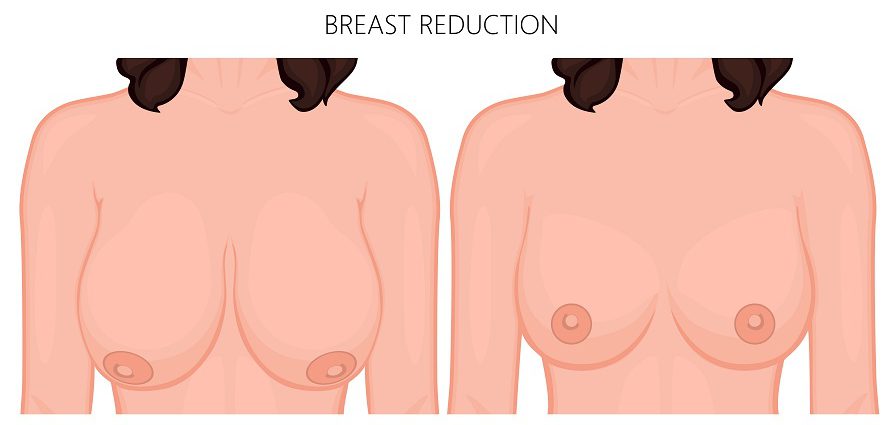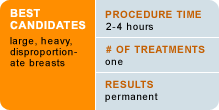Breast Reduction Surgery


Breast reduction (formally referred to as reduction mammoplasty) is a plastic surgery procedure for women with excessively large, pendulous breasts, a condition known as breast hypertrophy. Overly large breasts can cause both physical and psychological problems, including:
- Back and neck pain
- Inflammation beneath the breast folds
- Soreness from bra straps digging into the skin
- Limitations on physical activities
- Increased self-consciousness
- Emotional discomfort resulting from unwanted attention
- Decreased self-esteem
By removing excess skin, fat and breast tissue, and repositioning and reshaping the breasts, reduction mammoplasty can relieve the physical and psychological strains of overly large breasts and help women attain a more comfortable, proportionate and visibly appealing bustline.
Breast Reduction Candidacy
The best candidates for the procedure are women in good health at or near their ideal weight. Candidates also must have realistic expectations, be nonsmokers (or at least be willing to quit smoking for a time) and be able to follow pre- and postoperative surgical instruction.
Teenagers who have excessively large breasts also may be candidates for breast reduction. However, surgery can only be performed after the breasts have finished developing.
The Initial Consultation

The first step is to schedule a consultation with a board-certified plastic surgeon who has experience with all types of breast surgery. To get started on your search for the right surgeon, visit our plastic surgeon directory, which exclusively lists surgeons who are board certified by the American Board of Plastic Surgery (ABPS). Surgeons who are certified by the ABPS have achieved the highest levels of education, training and experience and are held in high esteem by their medical colleagues. By exclusively listing ABPS-certified surgeons, the Consumer Guide to Plastic Surgery Directory can help ensure you find the best doctor to assess your candidacy and perform your surgery.
During your initial consultation, your plastic surgeon will measure your breasts in relation to your frame and take “before” photos of your breasts. He or she may also request a breast X-ray (mammogram) before surgery to rule out breast cancer or any other anomalies. You will also discuss your potential candidacy, expectations, risks, breast reduction costs and benefits with your surgeon. The procedure should be explained in detail, and all your questions should be answered. Also ask to see before and after breast reduction photos to get an idea of what type of results you can expect.
The Procedure
Breast reduction procedures are typically performed with the patient under general anesthesia. Three main incision types are available:
- Around the areolas (the dark-colored skin encircling the nipples) – The surgeon makes incisions around the areoles and removes excess skin, fat and tissue before closing the incisions. This option is available only for women whose skin is highly elastic and will shrink to the breasts’ new shape.
- Keyhole incision – The incisions encircle the areolas and extend down to the breast folds in a flared pattern, similar to an old-fashioned keyhole shape. The surgeon removes the extra skin, tissue and fat and sutures the incisions. These incisions will leave vertical scars from the areolas to the breast folds.
- Anchor incision – As the name suggests, this incision is shaped like an anchor, encircling the areola, extending vertically to the breast fold and then continuing in both directions along the breast fold.
Your surgeon will help you decide which incision is best based on your unique considerations and goals.
Regardless of incision type, the nipple is typically moved to a higher location on the breast, although it usually remains connected to the underlying blood vessels and nerves. In some cases, the nipples may need to be removed and grafted to their new position.
Recovery
Following breast reduction surgery, your incisions will be covered with dressings or bandages. Drainage tubes may be inserted into your incisions to help prevent the accumulation of fluids. You may be asked to wear a support bra or elastic bandage to help support the breasts as they heal.
Your surgeon will give you detailed instructions about wound care and the resumption of physical activities. Be sure to follow all your surgeon’s instructions to ensure your breast reduction recovery goes smoothly. This will help you avoid side effects and ensure that your scars are as inconspicuous as possible.
Risks
As with all surgeries, complications may include infection, bleeding or reaction to anesthesia. Immediately after surgery, there may be some pain, which can be treated by a prescription from the plastic surgeon. If the pain is more severe, additional follow-up visits may be scheduled.
Loss of Breast and Nipple Sensation
Surgery may increase the possibility of nerve damage or reduced blood supply to the breast or the nipple. If this occurs, sensation can be lost temporarily or permanently in areas of the breast or nipple or both.
For very large breasts, it may not be possible to move the nipple and areola while leaving them attached to the nerves and blood vessels. In these cases, the nipple and areola may be removed and grafted into a new location on the breast, which may cause permanent loss of sensation.
There is also a risk that breast feeding will not be possible after surgery.
Permanent Scarring
Another side effect of breast reduction surgery is that it leaves permanent scars on the breasts. The vertical and horizontal scars are most visible, and scars remain after the breast is completely healed. Smoking blocks oxygen received by the body during the healing process, so for smokers, breast surgery scars are typically larger and less smooth. Any internal bleeding or excessive bruising caused by breast reduction surgery may also lead to increased scar size.
Some women are able to have a surgical procedure that requires fewer incisions, or incisions that are not as long. If the breast skin is elastic and the breasts are not too large, then liposuction can be used to remove the fatty tissue and shorter incisions can be used.
Breast Asymmetry
Another possible side effect of reduction plastic surgery is that the breasts may not be symmetrical in size and shape after surgery. Also, the nipple may not be positioned properly, or the nipples may not be the same height. During the procedure, the surgeon must remove a considerable portion of tissue and move the nipple while the patient is in a lying position. Advanced surgical skill is needed to estimate the exact nipple location and size-and-shape change, so that the breasts are symmetrical when the patient returns to an upright position.
Cost of Breast Reduction
The cost of breast reduction varies depending on several factors, including the extent of surgery, the surgeon’s level of experience and the geographical location, with surgery being more expensive in densely populated metropolitan areas than in less-populated rural locales.
The three main costs of surgery are the surgeon’s fee, the anesthesia fee and the facility (operating/recovery room) fee. Other expenses include medications, bandages and other items needed during recovery. Altogether, your breast reduction surgery may cost anywhere from $5,000 to $7,000.
Because it is performed to relieve physical and psychological symptoms, breast reduction is often at least partially covered by medical insurance. In addition, most plastic surgeons offer financing to help their patients afford the expense of surgery.
Breast Reduction for Men
While breast reduction is most often performed on women, a type of breast reduction surgery is available for men who suffer from enlarged male breasts, a condition known as gynecomastia. Although the procedural steps are obviously quite different for men, the goals of surgery are similar to those of women seeking surgery: relief from physical and emotional difficulties caused by excessive chest tissue.
Get Started
If you are ready to consult with a surgeon regarding breast reduction surgery, get started now by visiting our directory of ABPS-certified plastic surgeons.


